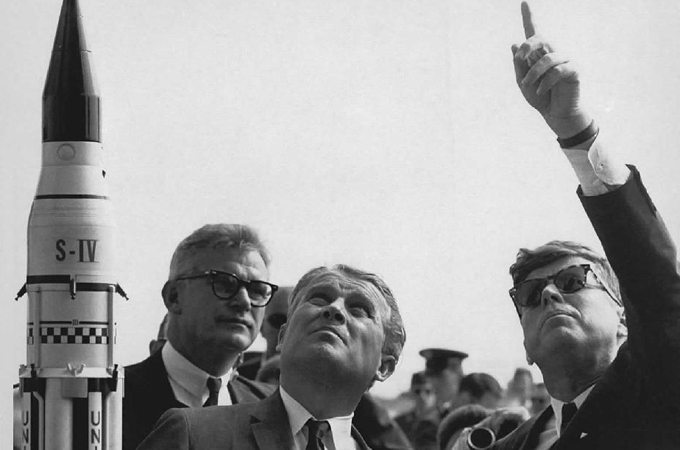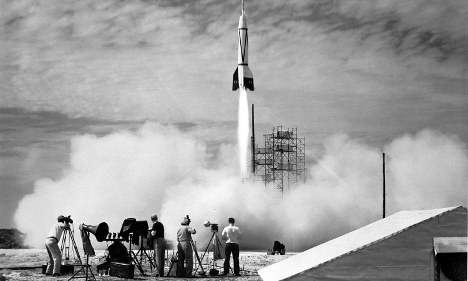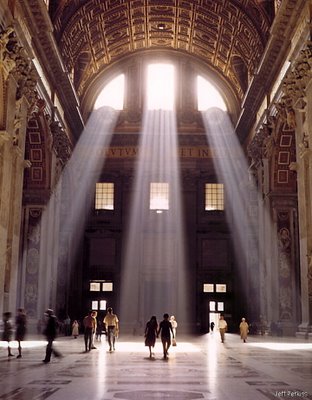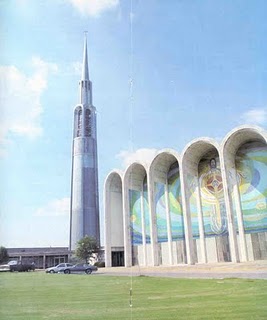Alex Constantine - November 1, 2013
Photo: Jack Parsons with unidentified rocket gear, 1936 (via)
Depending on whom you ask, I’m about to be sucked into a Hell portal that allegedly sits in caverns somewhere around NASA’s Jet Propulsion Lab.
The place looks almost calm from here – I’m standing midway across a footbridge over the Arroyo Seco canyon, near La Cañada Flintridge, California, a good quarter-mile southeast of the lab’s campus.
The old line is that JPL is really Jack Parsons’ Lab. Marvel “John” Whiteside Parsons, the late chemist, rocketeer and high school dropout had a hand in some of the first rocket tests on what would later become the grounds of the JPL, NASA’s famous rocket incubator.
It was the dawn of World War II when Parsons, who’d also co-founded the missile manufacturing firm Aerojet around the same time as JPL’s inception, took to the Ordo Templi Orientis. The OTOwas a Thelema-based, fraternal-religious sex-magick order founded by Aleister Crowley, the British mystic variously known as the Great Beast 666 and the “most evil man who ever lived.”
Parsons saw in Crowley a master-mentor figure. The Feds saw suspicious activity. In 1950, theFBI would investigate Parsons over the theft of rocket documents from the Hughes Aircraft Company; after being discovered, Parsons was immediately fired, and would later lose his top secret clearance. “He planned to submit [the documents] with [an] employment application through American Technion Society for employment in the country of Israel,” read the original FBIreport.
Whether or not Parsons was acting as an Israeli spy or simply being cavalier, his connection to the occult earned him special attention. The U.S. Air Force advised the FBI that the USAF hadalready collected files on Parsons and his relationship with Crowley, one of which, dated May 17, 1948, stated: “A religious cult, believed to advocate sexual perversion, was organized at subject’s home at 1003 South Orange Grove Avenue, Pasadena, California, which has been reported subversive…” “This cult,” it continued, “broadly hinted at free love”: there had been “several complaints of ‘’strange goings on at this home,’” and an unnamed source had described the church as “a gathering place of perverts.” Furthermore, “…women of loose morals were involved and…the story of Parsons’ activities had become fairly common knowledge among scientists in the Pasadena area.”
But soon enough the young explosives guru was running with another OTO buck, a young writer named L. Ron. Hubbard. When Parsons, then in his early 30s, wasn’t ranging the canyon beneath me, chanting mantras to Pan before field-testing one of NASA’s nascent projectiles, there’s good chance the guy could’ve been found with Hubbard, caught up in all manner of weirdo rites in and around the Arroyo Seco and greater San Gabriel Valley. It’s stuff you’d expect out of this sort of thing – wearing robes and bejeweled hoods; scheming to conceive a hulking Moonchild with Parsons’ mistress, dawning the Aeon of Horus; plotting the overthrow of 4D spacetime; drug-addled anal parties; animal sacrifices. You know. Cult stuff.
Parsons embrace of this seemingly double life is a knotty bit of history, though maybe not impossible to untangle. It could’ve been that because he wasn’t studying at neighboring CalTech – Parsons and only one other of the core of JPL’s founders weren’t fully immersed in academia, I’m told – the brilliant, if undisciplined Parsons had no qualms in latching onto the OTO. Or maybe it was the occult’s general grasp over southern California that pulled Parsons to the dark arts.
The rocket boys, 1936. That’s Parsons foregrounded on the right (via JPL / NASA)
Whatever it was, the move drew fire from some of his contemporaries. More poignantly, it triggered Parsons’ migration from JPL’s founder’s circle, a disparate group of aerospace experimentalists, mechanics, and others known as the “rocket boys,” and into the folks-y, tragicomic dustbin of national lab heroism. “As I write,” Parsons lamented in 1950, “the United States Senate is pursuing a burlesque investigation into the sphere of private sexual morals, which will accomplish nothing except to bring pain and sorrow to many innocent persons.” Parsons’ contentious modus operandi and his untimely, fiery demise may shed light on just why it is that we Americans choose to canonize some minds and not others. And perhaps it may even point to why popular opinion continually pits science and reason and religi-magic against each other as eternally incompatible forces.
Crowley says it was the sheer force of Parsons and Hubbard’s ritualisms around here that opened the portal. Still others say the steady beam of strange vibes over the region was so intensely powerful over Parsons that for him there become simply no other option besides rocketeeringhere, despite being trolled by the FBI. The Arroyo’s dark energies wouldn’t only boost rockets’ precision, Parsons thought. They’d have them cruising further, faster.
You’ve maybe been hearing a lot about this place. The brains behind JPL’s Mars Science Laboratory not only built and launched the Curiosity rover. They flawlessly parked the $2.5 billion drone on another goddamn planet.
We’re off the bridge, now, and back onto trail. A friend, John, guides my way off what I assume is sanctioned path. John’s got a monster stride. He breaks only when it’s absolutely necessary. He also hardly ever looks back over his shoulder, sparing himself the sad sight of me hobbling all sweaty and pathetically cryptid-like (people claim they’ve seen those here) because I suck and somehow managed to forget both shorts and hiking shoes. It’s bright, maybe 85 degrees, and I’m descending into semi-arid brush – maybe even a portal to Hellfire – in jeans and busted canvas lowtops.
We hop a chain-link fence. A riparian zone rich in massive willows and various wildlife, this area is a magnet for hikers, joggers, paranormal enthusiasts, equestrians, graffitists, young people tripping acid, assorted weirdos. Together their meanderings have carved a network of paths that hit damn near every last bluff, brook, and crevice defining this narrow slice of the Arroyo. Whatever trail we were on certainly wasn’t over beginner, either. And from what I see up ahead – an open-air, paved staircase pacing down about 50 yards, then jutting left, out of sight – I probably can’t say much different about how it’ll be getting to wherever we’re going.
But this is still unforgiving land. You’d be an idiot to think that veering out of bounds, as I assume we’re doing, isn’t without risks. You stress something awful when knowing full well the price tag on getting air-lifted from some ashen gulley after snapping a tibia because your shoes are essentially equivalent to a second pair of socks.
JPL campus and San Gabriel mountains, looking east (via JPL / NASA)
We rest a while. John says we’re on course for the bowels of the Devils Gate Dam, a barrier that’s defined the land since 1920. But long before then, long before Parsons showed up, the Tongva, an indigenous tribe whose territory once spanned present-day San Gabriel, had been picking up bad vibes from a particular run along the Arroyo Seco River. They could see the devil’s face right there in the rockside, so much so that tribe members were apparently forbidden from straying too close to the horned visage. Centuries later, when the county needed a name for its gaudy new flood-control project, the choice was easy: Devil’s Gate. So sure enough, as we start again a white sign rises from the brush: County of Los Angeles Department of Public Works – DEVILS GATE DAM.
And that’s just it. Forget the natural splendor; I’m struck by a prevailing sense of an immense, crushing infrastructure. This place is testament to an enduring compulsion to tame nature – or overcome Her forces, in the case of Parsons. His explosive fuel studies and pioneering work with solid-state rockets and JATO, or jet-assisted takeoff, have over the years led some, including the late Hungarian-American aerospace engineer Theodore von Kármán, to go so far as crediting him with launching the era of modern space travel.
But others aren’t so quick to call Parsons NASA’s unsung hero.
“I think that’s going far too far,” JPL Historian Erik Conway will later tell me. “Very far, too far.”
Parsons, middle, and colleagues watch the U.S.’s virgin jet test (via NASA)
Records from the period are scant. Which is unfortunate – being an experimentalist but also tremendously undisciplined, Parsons didn’t make strides in a normal, scientific sense. He didn’t log the particulars and progress of his trials, as any diligent experimentalist would. He didn’t publish papers.
“He didn’t contribute to the literature in that way,” Conway goes on. “He lacked that kind of rigor.”
What he lacked in methodic restraint he might have recouped in auras siphoned off the land. Because this is the place, it seems; this is where the bullheadedness of man – drunk on science, God, sex-magick, or some cocktail thereof – gives the wilds a run for their money. I’m in a page ripped from the book on great American public works and civil engineering. I’m in a fucking cathedral of cement, flanked by the towering underpass of Pasadena’s so-called Suicide Bridge (Hwy. 210) and the Devil’s Gate itself. Through it all, crusties claim, bores a labyrinth of tunnels. I partly buy this – John and I have been through a few, already. If I were any more conspiratorial or crusty, I would also buy the one about all of this merely being part of a network of tunnels coursing beneath all of LA.
I can’t say if any of this explains why I’m trudging down here, exactly. I’m not sure what even to expect. I don’t think John knows, either, and it’s not like this is his first trip down. John first heard of the spot – the actual, physical Gate in Devil’s Gate – and its curiosities from some dude over in Sierra Madre. A cursory search online then turned up the bit about Parsons and Hubbard and the alleged Hell portal, but also how the Gate meets the river at the mouth of a tunnel. And that if you’re up for it, there’s a way to get there.
John tells me it’s little more than a blockade of cell bars, a failed attempt by the county at preventing curious trespassers from entering the tunnel, which bores horizontally back into the rock, back toward the dam itself. I assume it acts as a kind of overflow-relief valve, if in fact it’s still functioning. John’s not sure. He’s never gone in. The one time he gazed into what some folks would tell you is one of just a handful of terrestrial Hell portals, he had to bail before setting foot inside the roughly 10-foot by 10-foot tunnel. Apparently the rest of his crew bummed so hard on a horrific stench eking from the lightless shaft that consensus aborted their mission. John smelled nothing.
The Devil’s Gate Dam in 1923
I’m sure it’d be a trip to at least brush the edge of a vortex to the dark side, if such a Hellscape existed. You know, just have a real, “Oh, wow.” To think, the gate was unlocked. They could’ve been how close? Wow.
This holds for pretty much any portal – to Mars, to other dimensions, other times. But at the moment, at least, I’m just starting down these stairs. I can’t possibly be slipping into Hell. I just can’t be. I don’t feel any different. No sudden rush of biting, wicked vibes. No crawling skin. My teeth are noticeably unclenched.
But I’m not looking for Hell, or its chute. I’m not looking for any robed orgy, or the residues of some of NASA’s first fuel reserves. I’m definitely not looking for the stains of an end-times infant homunculus à la 2001 (or even Rosemary’s Baby), only utterly failing. Of course stumbling on any of those would be a real wow. But just knowing that Parsons’ genius – a largely innate, at times feared prowess that however unorthodox helped launch rocket science before “rocket science” became the stuff of household chortling – spellbound him to the dark arts, that exerts a pull of its own.
Parsons once wrote of himself as an “Antichrist loosed in the world,” pledging to carry out the word of “the Beast 666.” So if he took pains to sink his hands into both pots, as if to shatter what he saw as a bunk dichotomy between the supposedly cool, collected march of science and the maelstrom of esoteric sorcery, I don’t want to suck the cursed marrow from the non-existent bones of the OTO’s botched Hellchild so much as jaunt through a patch of strange land, the throbbing of which has since left Parsons noticeably absent from both the American subconscious and pop-sci record. Because who were you taught about in grammar school, Enrico Fermi or Jack Parsons?
These stairs, though. They’re the kind that if only could’ve been set just a bit deeper and longer would make getting pulled down into Hell not look like a stutter-step cavort. There’s a drop-off ahead. I don’t know how I feel about it.
John, descending (via B. Anderson)
The ladder is caged. It’s slick iron to the very bottom, years’ worth of hand grime rubbed into the 50-some odd rungs I counted off. There’s a platform about 20 feet from the top of the rockface, at which point, descending another 30 feet to the river’s edge, you realize that the mighty Arroyo is actually shallow-looking and seemingly non-flowing, a chalky-orange standstill of what otherwise cannot be described as sewage. Maybe it’s just the season, but I smell nothing particularly rank.
Most likely the water takes its stain from the same mud notorious for plugging the basin in back of the dam, toward JPL’s campus. An estimated 1.5 million cubic yards of mud have amassed at the Devils Gate since 2009’s Station fire, leaving some to argue that floodwater simply has nowhere to go. Coupled with the 100,000 cubic yards of mud already deposited here, built up between 1994 and 2009, there’s now enough of the orange goop to fill a good four Rose Bowl stadiums. The Los Angeles Times even reported that it would take as little as 40 minutes, under a worst case scenario, for torrential rains to send enough mud, rock and water hurtling over the gates to flood all of south Pasadena and northeast LA.
So standing here, face to face, now, with the stone Devil, part of me wants to say JPL’s site selection was maybe not the best thinking. Not awful. But, really? Right smack at the head of a floodplain?
What became the Jet Propulsion Lab was actually first an Army outpost. It was only grafted ontoNASA a few months after four other research centers scattered around the country were merged to form the agency, which, according to Conway, is a product of the now defunct federal aerospace organization, the National Advisory Committee in Aeronautics, or NACA. Doesn’t quite roll off the tongue as easily.
I’m sure for Parsons the Tongva legend may’ve only added to the Arroyo allure. I, for one, am really not buying the hex thing. The idea that by traipsing down to the Devil’s Gate I’m now flirting with the possibility of the cloud of misfortune hanging over the rest of my days stinks of the well-worn trope of the “ancient Indian curse.” We’ve all heard that one before.
True, on Halloween, 1936, the rocket boys did stake their professional reputations on hauling a ramshackle rocket motor out to the Arroyo to try and make a bang. They tested four times that first day. Trials culminated in a blown oxygen line that whipped and cracked in the late-afternoon chill, with untamed, fire-spitting abandon. And while I’m sure that all of this could – and maybe has – made for some seminal urban legends, I just can’t bring myself to say that any claims of JPLspells stem from either ancient pagan harvest festivals or celebrations for the dead.
Another rocket-boy Arroyo test gone up in flames, late November, 1936 (via JPL / NASA)
I don’t know. And yet there’s really no getting fully around the general vibe that something here is almost uncanny. Almost.
On top of the Tongva’s claims and all the mud and flood threats, the disappearances of at least four children in the late 1950s adds a particularly grim air to the Devils Gate surroundings.
Bruce Kremen, 6, was out on the trails with a summer camp group. Tommy Bowman, 8, was hiking with his family. Others, like Donald Lee Barker, 13, and Brenda Howell, 11, were out bicycling around the dam. All seemed to vanish into thin air, almost as if vacuumed down some earthly ingress. Here’s hoping we don’t experience similar fates.
“Ah, fuck,” John mutters, shaking the chains that hold the Gate shut. “It’s locked.”
Only leave it to some bolt-cutting speed freak to have nipped off just enough of a gap in the Gate to slink your body through. We go in. With no flashlight, it’s increasing darkness up a slight, maybe 7- or 8-degree incline for about 600 feet. We hit a dead end. How this would relieve dam overflow, as this doesn’t appear to be an active valve, is beyond me. It’s almost like the thing has been plugged.
But that’s it. No wildly shifting temperatures. No crippling stench. Still no crawling skin. Just some amateur graffiti, and the occasional flicker of smashed glass bottles. We turn around, and in relative silence walk out from the maw, and back toward the light.
“Well shit, man,” John, after a moment. “Do you feel any bad vibes?”
“Not really?” I admit. “I mean, maybe some weird vibes back at the end, there, but none right here. You know? None right now.”
Looking back toward the Gate from the tunnel’s approximate midway point (via B. Anderson)
Crossing back over the footbridge, the JPL beams silver across the basin. While I’m fairly certain that I haven’t been consigned to living in an underwhelming sort of utero Xenuian Hellscape, I can say that California is still totally fucking weird.
Hubbard, of course, would go on to further establish himself as a pulp sci-fi novelist and eventually found the Church of Scientology. His relationship with Parsons would self-destruct when he absconded with Sarah Northrup, Parsons’ mistress, who would become Hubbard’s personal auditor and instrumental to his writing of Dianetics. Crowley had warned Parsons that Hubbard was a con man, and indeed, when Hubbard and Cameron eventually abandoned Parsons and their nascent business plan to start a boat dealing company, they absconded for a port in Florida with Parsons’ boat and over twenty thousand dollars of Parsons’ savings.
Sarah Northrup, Parsons’ mistress, absconded with and later divorced Hubbard.
Upon learning of their escape, Parsons retreated to his hotel room and attempted to summon a typhoon in retribution with an evocation of Bartzabel, an intelligence presiding over the astrological forces associated with the planet Mars. A squall at sea ripped the sails from the boat, and Hubbard and Sarah were forced back to port where they were detained by the U.S. Coast Guard. Northrup would later divorce Hubbard, calling him “insane.”
In 1969, Caltrans heavy-equipment operator and noted LA County serial killer Mack Ray Edwardsadmitted to slaying little Donald and Brenda, and to later burying their remains in freshly lain highways. A year later, Edwards would hang himself at San Quentin. The disappearances of Tommy Bowman and Bruce Kremen remain unsolved.
As for the mud, some want to see the orangish glop hauled away, and quick. The LA County Public Works Department stated in an urgent 2011 report that the reservoir “no longer has the capacity to safely contain another major debris event,” and warned of “significant” risks of flooding and debris flow “below the dam”. Meanwhile, the city, out of concern for the willows and riparian wildlife, is saying hold it, let’s carry out a two-year environmental feasibility study into hauling out the muck. Temporary measures – hauling out 25,000 cubic yards of the stuff currently plugging one of the dam’s drains, namely – are one thing. The Public Works proposal, which would have 300-400 dump trucks daily hauling in and out of the Arroyo Seco, removing mud, is another.
“The better approach would be to have an ongoing sediment management program,” Tim Brick, managing director at the Arroyo Seco Foundation, told the Times. Better taking away only “some [mud] every year,” Brick continued, “rather than one big project that was going to amount to 400 trucks a day for three years.”
Or, as one morning walker put it: “It’s just a beautiful place. It takes a long time to make another tree.”
All copyright crashes aside, the Curiosity rover upped its camera not long after sticking its landing, and as of this writing has already found evidence that at one point, likely billions of years ago, steadily-flowing water cut through the JPL drone’s Martian stomping grounds, an area known as Gale crater.
“It becomes just an incredible exercise in engineering to make sure that it’s all going to work,” Jim Adams, NASA’s deputy chief technologist, told me on the eve of Curiosity’s hellraising touchdown in early August. “And then in a moment, all you can do is sit back and let the computer do its job.”
Proof, I’d wager, of a non-curse. Or as others might call it, magic. Weeks later, I asked Adams if he’d ever heard of Parsons. He hadn’t.
I don’t totally blame him. The JPL has taken pains to “not sanitize anything,” according to Conway, who reminds me that Parsons is given ample time in a three-part documentary film on the history of the lab that JPL released a few years back. The trilogy, entitled The American Rocketeer – Explorer 1 – Destination Moon, was subsequently given to every member of the lab’s staff. It was screened at CalTech, and also ran on a local television network.
But even still, it’s like the Jet Propulsion Lab remains near obscurity across a great swath of the U.S. The lab’s bread and butter – let alone the camp double-life of just one of its founders – remain at the margins of American consciousness. Every year, Jack Parsons’ Lab hosts an open-house weekend that draws some 3,500 visitors to its campus. Given the open-door vibe, Conway says he’s always stunned when he hears about area residents, some living mere blocks away, who have no familiarity whatsoever as to the regular goings on at JPL. I don’t totally blame him, either.
But to hear that some folks beyond the Devils Gate, including NASA brass, haven’t heard of Jack Parsons? Conway asks. “That doesn’t stun me at all.”
Parsons held onto both horns ‘til the bitter end, quite literally before the flames took him. He died of wounds after setting off an explosion of Mercury (II) fulminate in a basement experiment gone horrifically wrong, on June 17, 1952. He was 37.
The tragic, untimely death has since sparked numerous rumors as to just what, exactly, the eccentric rocketeer was up to in his final hour. Had he actually been keeping detailed records, we’d maybe have some closure. To Conway’s knowledge, the OTO, which claims global membership to this day, has never reached out to the JPL. So whether Parsons met his end brewing the next generation of NASA’s jet propellant, or cooking up the lifeblood to Crowley’s ultimate reveal, is anyone’s guess.
Maybe it’s best we never know. History may well come to judge Parsons’ blaze of glory as the ultimate redemption, a disruptive marrying of science and sorcery. Think about it. Both fields receive equal amounts of flak, and it’s no small coincidence that quite often it’s the champions of one who wage war on the other. Both stand on the shoulders of what for lack of a far better word can only be deemed as a kind of faith – faith that bold, leading-edge research will overcome the underlying mechanisms of this world to see all our rockets and space drones cruising further, faster, and with freakish precision; faith that the summoning of Pan’s good graces will provide that extra boost.
And for Parsons, at least, it was like retaining a moral imperative to embrace both the theoretically explainable and the fog of magic with equal aplomb, to demonstrate a surmounting over that which many others deemed unconquerable, trolls be damned. As he wrote three years before the accident:
It has seemed to me that if I had the genius to found the jet propulsion field in the US, and found a multimillion dollar corporation and a renowned research laboratory, then I should be able to apply the genius in the magical field.
And while he may’ve never raised that moonbaby, he eventually got there, and in no small way. Twenty years after his passing, the International Astronomical Union named a far-side moon crater (37N 171W) after Parsons, in a nod to his pivotal contributions to solid-fuel rocketeering. If that’s one stop along the figurative Hell portal, then we should all be diving in, now.
http://motherboard.vice.com/blog/crawling-back-to-the-alleged-hell-portal-of-nasas-occult-origins








